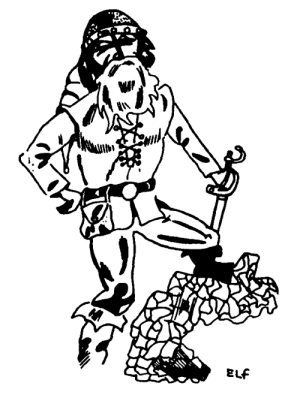
2024-01-01

I believe that an understanding of OD&D lends itself to an understanding of AD&D and vice-versa. But until last week, I never read through the OD&D books in full. What follows is part 1 of a series of posts where I'll share the notes I took while reading.
Here are my notes from Volume 1: Men & Magic.
We advise, however, that a campaign be begun slowly, following the steps outlined herein, so as to avoid becoming too bogged down with unfamiliar details at first. That way your campaign will build naturally, at the pace best suited to the referee and players, smoothing the way for all concerned. New details can be added and old "laws" altered so as to provide continually new and different situations. In addition, the players themselves will interact in such a way as to make the campaign variable and unique, and this is quite desirable. -- pg. 4
The bottom-up campaign approach Gary suggested in the April 1975 Europa article, on which the Gygax 75 challenge is based. I used this for my current AD&D campaign, and will never use another strategy again.
keep the rules nearby as you play. A quick check of some rule or table may bring hidden treasure or save your game "life". -- pg. 4
My style is pro-player-knowledge. I like when the players reference the books, and players regularly check all the game books while playing. One might be surprised to see in the AD&D DMG when Gary heavily discourages non-DMs from reading the DMG,1 when most of the tables that would be useful for saving a life are found therein (saving throws, for example).
If a Patriarch receiving the above benefits changes sides, all the benefits will immediately be removed! -- pg. 7
Reinforcement of my view of alignment: sides in a cosmic conflict.
Intelligence will also affect referees' decisions as to whether or not certain action would be taken -- pg. 10
It's not clear here whether the intention was for the referee to veto PC actions based on low PC intelligence, or if this line was for monsters only. For example, restricting what ideas a PC with INT 5 could come up with, despite the player's own intelligence. Personally I am not a fan of this, and prefer to use INT for game mechanics alone when it comes to PCs. I like to maximize the influence of player skill at the table.
Finally, the charisma will aid a character in attracting various monsters to his service. -- pg. 11
Overall, I found OD&D to more heavily and directly suggest that taking monsters into service is common game behavior, and a core part of the game. In AD&D, there isn't as much language to this effect. Such cases in the AD&D rules are typically the result of magic. If you're an experienced old-school D&Der you know that an exceptional reaction roll can certainly result in monster allies. But if a neophyte D&Der were to read both OD&D and AD&D, they'd find the "you can get monster allies" message to be clearer in OD&D.
While not understanding the language, creatures who speak a divisional tongue will recognize a hostile one and attack. -- pg. 12
Cool precedent for alignment languages being identifiable by other sides.
An "Uncertain" reaction leaves the door open to additional reward offers, but scores under 6 do not. -- pg. 12
Here we have an explanation for the "uncertain" results on DMG 63! The AD&D reaction table there has "Uncertain but 55% prone toward negative", and "Uncertain but 55% prone toward positive" as possible results. Taking this OD&D text into account, a DM could interpret the AD&D results to mean that the reaction will be either negative or positive by default, but could be swayed by the PCs. A DM could even go as far as to consider the given percentages here. For example, on "Uncertain but 55% prone to negative" result, if the PCs offer more in a parley, the DM could dice a 55% chance for the new offer to be rejected as well. Or if the offer is particularly rich or poor, the DM might apply a modifier to that roll. Cool. Always felt weird to me that those two AD&D table results merely meant "roll again, against a 55% chance".
At this time the relative would inherit the estate of the character, paying a 10% tax on all goods and monies. The relative must start at the lowest level of the class he opts for, but he will have the advantage of the inheritance. -- pg. 13
A will/inheritance rule! At your option, pair this with the rules for wills in the Judges Guild Ready Ref Sheets,2 and you're off to the races. I don't know of an equivalent rule in AD&D.
Gains in experience points will be relative; thus an 8th level Magic-User operating on the 5th dungeon level would be awarded 5/8 experience.
Similar vein but different from the AD&D XP ratio rules,3 which consider total party level. I think the AD&D rules are probably better. OD&D would allow a 1st level magic-user to get full XP when operating with a 20th level magic-user on the first level of the dungeon.
a strong anti-magical creature will shatter it -- pg. 23
Lends itself to precedence in AD&D for a monster with magic resistance being able to use that magic resistance to break magic on objects, such as held portals. I can't remember if there is explicit language in AD&D to that effect, but that is how I run the game.
Detect Evil: A spell to detect evil thought or intent in any creature or evilly enchanted object. Note that poison, for example, is neither good nor evil. -- pg. 24
Well, poison is evil in AD&D, but just like in OD&D it would not be detectable by detect evil. See also: Detect Evil Is Not Detect Alignment.
Clairvoyance: Same as ESP spell except the spell user can visualize rather than merely pick up thoughts. -- pg. 25
If this was your first D&D experience, you might have been inclined to read this spell as granting the full capabilities of the ESP spell PLUS those of visualization. It's certainly a weird wording to someone from the future, like myself. Clairvoyance grants no ESP capabilities in AD&D.4
Use a random determination on the Character Alignment table, and whatever the result is, the reincarnated character is that creature and must play as it. ... roll a six-sided die to determine which level in that class -- pg. 30
More precedent for reincarnation being intended to create a playable character. Pairs nicely with DMG 44. I wrote more about this on Demon Idol's Reincarnation page. Interesting to see that d6 mechanic; there are no guidelines for resultant character level in AD&D.
Continual Light: This spell is the same as that for Magic-Users, except that the light shed is equal to full daylight. -- pg. 32
In AD&D there is no such difference between the two continual light spells. Instead, the cleric version has a 12" range instead of 6" (but same light AoE), and can be reversed (the magic-user's version cannot be reversed).5
Part 2: Monsters & Treasure
DMG 7.
JG RRS 7: "There is an estate tax of 10% (60% if relative had a monopoly) and a 50% chance that any magical item is confiscated for state protection. Magic items not confiscated are taxed based on highest total value 10%. Wills are registered for 10 GP fee. Unregistered wills are considered void."
DMG 84.
PHB 73.
PHB 46, 69.